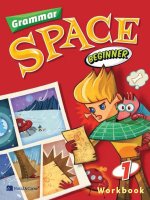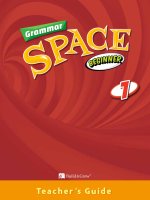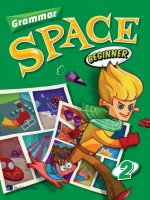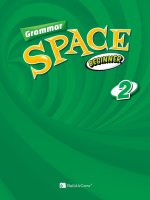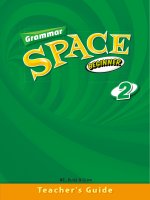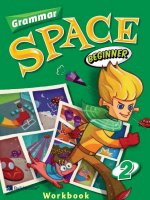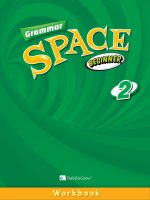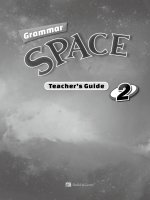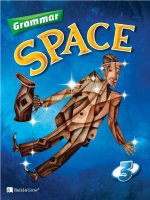Grammar space beginner 3 TG
Bạn đang xem bản rút gọn của tài liệu. Xem và tải ngay bản đầy đủ của tài liệu tại đây (22.17 MB, 74 trang )
r
a
m
ram
G
i n n er
g
e
B
3
Te a c h e r ’s G u i d e
Grammar Space Beginner 3
Contents
2
Grammar Space Beginner 3 Teacher’s Guide
3
Unit 1 |
Jeff Reads Many Books.
Grammar Station
1. Read the sentences at the top of the Grammar Station section as a class. Explain to
the students that a sentence is made up of a subject and a predicate. Tell them that
the subject is who or what the sentence is about and can be a noun or a pronoun.
The predicate is the rest of the sentence after the subject and says what the subject
is or does. The predicate must include a verb.
Objectives
1. The students will learn about the parts of a sentence.
2. The students will complete exercises to familiarize themselves with the key grammar
point.
3. The students will identify and correct simple mistakes related to the key grammar
point.
4. The students will apply their new grammar knowledge in a practical writing exercise.
5. The students will review the grammar point before the end of the class to aid
retention.
2. Ask the students to look at the chart. Read the subjects and the predicates in the
chart as a class. Then choose individual students to read the example sentences
under the chart. After each sentence has been read, ask the class to call out the
subject and predicate in the sentence.
3. Extra Idea (optional):
Split the class into two teams. Have one team read the first subject in the chart.
Encourage them to change their voices by making them louder, quieter, higher, lower,
etc. Then ask the second team to read the first predicate. Tell them to read it the
same way that the first team did. Have the two teams switch roles.
4. Read the sentences as a class. Then ask the students to circle the subjects. Check
the answers as a class. Write extra sentences on the board. Have the students take
LESSON GUIDE
Introduction
turns coming to the front. Tell them to read one of the sentences out loud and then
flip a coin. If the coin lands on “heads,” they will circle the subject. If the coin lands
on “tails,” they will circle the predicate.
1. Ask the students to read the unit’s title out loud. Write it on the board to use as an
example later.
2. Scan the unit before the class starts and identify any words that your students may
not understand. Then at the start of class, post pictures or write simple definitions
of the words on the side of the board for the students to refer back to throughout the
class.
Check Up
As you work through the check up and practice exercises, walk around the classroom
and encourage the students to ask you questions if they ever get confused. Also, make
4
Grammar Space Beginner 3 Teacher’s Guide
5
sure to check each exercise and explain any common errors so that the students can
correct their answers and learn from their mistakes.
Practice
1. Read the sentences as a class. Then tell the students to put a slash between the
1. Read the sentences together as a class for exercise A. Then ask the students to look
at the underlined parts and check whether they are subjects or predicates. Check the
answers as a class.
Afterward, have the children think of similar sentences. Write down the sentences
they call out on the board. Then choose some of the students to come to the front.
subjects and the predicates. Check the answers by having some of the students read
the sentences out loud and saying “slash” where the slashes should be. Encourage
each student to change their voice in a funny way when they say “slash.” Afterward,
write more sentences on the board and let other students take turns reading them and
saying with a funny voice where the slashes should go.
Have them take turns underlining either the subject or the predicate in each sentence
and then asking the other students which one it is.
2. Look at the pictures for exercise B. What do the students see in each picture? What
is the name of their best friend? Tell the students to use the words in the box at
2. Look at the pictures at the top of exercise B as a class. What do the students see
in each picture? Do they know what city is in the last picture? Have they ever visited
there? Ask the students to match the subjects with the predicates. Check the
the top of the activity to complete the sentences. Check the answers as a class.
Afterward, ask the students to think of other words that can be used to complete each
of the sentences.
answers as class
3. For exercise C, tell the students to correct the underlined words and then rewrite
3. Extra Idea (optional):
Write subjects and predicates all over the board. Draw a box around each one. Give
a student a foam ball and tell them to try and hit one of the boxes. If they hit a box,
the sentences. Have the students check their answers with a partner. Write similar
sentences on the board. Put errors in most of them, but write a few with no errors.
Choose some of the students to come up and fix your mistakes.
ask them if it contains a subject or a predicate. Then have them add a subject or a
predicate to it to make a full sentence.
4. Start off exercise C by reading all of the sentences as a class. Ask the students if
the first sentence (“I eat healthy food every day.”) is true or false for them. If it’s
false, why don’t they eat healthy food every day? Have the students look at all of the
sentences again. Tell them to circle and write the verbs in the underlined predicates.
Check the answers as a class.
Grammar in Writing
1. Emphasize to the students that this writing exercise ties the grammar they have
learned into practical writing for the future. Start the exercise by asking general
questions about the writing type. Some possible ideas are:
a. When do people make a speech?
b. Have the students ever had to give a speech?
c. What are some good things to do when giving a speech?
2. Look at the picture as a class. What do the students see in the picture? What do
6
Grammar Space Beginner 3 Teacher’s Guide
7
they think the boy’s speech will be about? Tell the students to use the words in the
ANSWER KEY: STUDENT BOOK
box at the bottom of the exercise to complete the speech. Check the answers as a
class. Then have the students read through the speech together.
3.Extra Idea (optional):
Have the students write their own speeches about why people should vote for them
to be class president. Ask them to think of three things that would make their school
better and then to use the exercise as a guideline for writing their speech. Check
everyone’s speeches for any spelling or grammar problems. Then have the students
take turns reading their speeches at the front of the class.
Review and Workbook
1.Tell the students to complete the chart at the bottom of the page as fast as they can
as a review. They shouldn’t have any problems with it by this point. While they do that,
put the chart’s structure on the board. Have the students fill it in for you as they start
finishing up.
2.Before class, print enough unit review tests for all the students from www.
nebuildandgrow.com (For Teachers → Test Sheets → Grammar → Grammar Space
Beginner 3). When everyone is finished with the review chart, have all the students
take the tests on their own. If possible, have them check their answers with a partner
or go through the tests all together before the end of class. If the students struggled
with any of the test questions, review the material some more.
3.The corresponding workbook unit is intended as homework so the students can
review what they have learned at home. However, you can also go through the
workbook in class if you would like to be present for additional grammar practice
with the students.
8
Grammar Space Beginner 3 Teacher’s Guide
9
ANSWER KEY: WORKBOOK
Unit 2 |
I need a lot of sugar.
Objectives
1. The students will learn about the quantifiers many, much, and a lot of.
2. The students will complete exercises to familiarize themselves with the key grammar
point.
3. The students will identify and correct simple mistakes related to the key grammar
point.
4. The students will apply their new grammar knowledge in a practical writing exercise.
5. The students will review the grammar point before the end of the class to aid
retention.
LESSON GUIDE
Introduction
1. Review the previous unit (subjects and predicates) before starting your lesson. Show
each student a sentence on a flashcard with either its subject or predicate underlined
and have them identify which part of a sentence it is (subject or predicate).
2. Ask the students to read the unit’s title out loud. Write it on the board to use as an
example later.
10
Grammar Space Beginner 3 Teacher’s Guide
11
3. Scan the unit before the class starts and identify any words that your students may
to throw it at the grid. If they hit one of the squares, tell them to say the noun and
not understand. Then at the start of class, post pictures or write simple definitions
ask them what quantifier goes with it. If they say the correct quantifier, ask them to
of the words on the side of the board for the students to refer back to throughout the
put their team’s symbol (X or O) in the square. Then ask them to try and use the noun
class.
and quantifier in a sentence. The first team to make a straight line with three of their
symbols is the winner.
Grammar Station
1. Read the sentences at the top of the Grammar Station section as a class. Explain to
the students that the words “many,” “much,” and “a lot of” all mean a large number
Check Up
1. Read the nouns in the picture frame in exercise A together as a class. Then ask
or amount. Tell them that we use “many” with plural count nouns and “much” with
the students to write the nouns in either the count or noncount column. Check the
noncount nouns. Teach the students that “a lot of” can be used with both plural and
answers as a class.
noncount nouns.
2. Extra Idea (optional):
2. Ask the students to look at the chart. Read the count and noncount nouns along
Have a spelling race with the nouns from the exercise. Split the students into two
with the quantifiers as a class. Then choose individual students to read the example
teams. Ask a member of each team to stand at the back of the class. Tell them
sentences under the chart.
one of the nouns and practice spelling the word together several times. Then shout
“Go!” and have them run to the board and write the word down. Whoever finishes
3. Read the sentences as a class. Then ask the students to circle the correct words.
Check the answers as a class. Write “many,” “much,” “and a lot of” at the top of
first scores a point for their team. After the students have written down the word, ask
them if it is a count or noncount noun.
the board. Then write extra count and noncount nouns all over the board. Have the
students take turns coming to the front. Tell them to choose one of the nouns and to
3. Read the sentences for exercise B as a class. Ask the students if they drink a lot
write the proper quantifier next to it. Have the class vote on whether they think the
of water and/or if they have a lot of homework today to personalize the sentences
answer is correct or not.
for them. Then ask the students to read the sentences again and to change “a lot
of” into either “many” or “much.” Tell them to write the correct words next to the
4. Extra Idea (optional):
sentences. Check the answers as a class.
Play tic-tac-toe with the nouns from the exercise. Draw a 3x3 grid on the board and
write the nouns in each square (there are eight nouns and nine squares, so ask the
12
4. Look at the pictures for exercise C as a class. What do the students see in each
students to think of one extra count or noncount noun). Split the students into two
picture? Ask the students to read the sentences and fill in the blanks with “many” or
teams (team X and team O). Give a student from one team a foam ball and ask them
“much.” Check the answers as a class.
Grammar Space Beginner 3 Teacher’s Guide
13
Practice
in the box at the bottom of the exercise to complete the story. Check the answers as
a class. Then have the students read through the story together.
1. Write “many,” “much,” and “a lot of” on the board. Have the students take turns
making their own simple sentences with each of the quantifiers. Then ask the
students to read the sentences in exercise A. Have them circle the correct quantifiers
and write them in the blanks. Check the answers as a class. Afterward, write
sentences on the board that are similar to the ones in the exercise. Leave blanks
where the quantifiers should go. Choose some of the students to come to the front
and fill in the blanks with the correct quantifiers
3. Extra Idea (optional):
Have the students write their own stories. Tell them to make their stories similar to
the one in the exercise but to think of different animals, and a different type of food for
one of the animals to carry on their back. If the students have time, encourage them
to draw some pictures for their story as well. Check everyone’s stories for any spelling
or grammar problems. Then have the students take turns reading their stories and
showing their pictures to the class.
2. Look at the picture for exercise B. What do the students see in the picture? Do they
have any similar items as Harry? Tell the students to circle the correct quantifiers and
use the words in the box at the top of the activity to complete the sentences. Check
the answers as a class.
3. For exercise C, tell the students to correct the underlined words and then rewrite
the sentences. Have the students check their answers with a partner. Write similar
sentences on the board. Put errors in most of them, but write a few with no errors.
Choose some of the students to come up and fix your mistakes.
Review and Workbook
1. Tell the students to complete the chart at the bottom of the page as fast as they can
as a review. They shouldn’t have any problems with it by this point. While they do that,
put the chart’s structure on the board. Have the students fill it in for you as they start
finishing up.
2. Before class, print enough unit review tests for all the students from www.
nebuildandgrow.com (For Teachers → Test Sheets → Grammar → Grammar Space
Grammar in Writing
1. Start the exercise by asking general questions about the writing type. Some possible
ideas are:
Beginner 3). When everyone is finished with the review chart, have all the students
take the tests on their own. If possible, have them check their answers with a partner
or go through the tests all together before the end of class. If the students struggled
with any of the test questions, review the material some more.
a. How often do the students write stories?
b. What kind of stories do the students like?
c. What is each student’s favorite story?
3. The corresponding workbook unit is intended as homework so the students can review
what they have learned at home. However, you can also go through the workbook in
class if you would like to be present for additional grammar practice with the students.
2. Look at the pictures as a class. What do the students see in the pictures? What do
they think the story will be about? Tell the students to use quantifiers and the words
14
Grammar Space Beginner 3 Teacher’s Guide
15
ANSWER KEY: STUDENT BOOK
16
ANSWER KEY: WORKBOOK
Grammar Space Beginner 3 Teacher’s Guide
17
Unit 3 |
She has a cup of coffee.
3. Scan the unit before the class starts and identify any words that your students may
not understand. Then at the start of class, post pictures or write simple definitions
of the words on the side of the board for the students to refer back to throughout the
class.
Objectives
1. The students will learn about noncount nouns.
2. The students will complete exercises to familiarize themselves with the key grammar
point.
3. The students will identify and correct simple mistakes related to the key grammar
point.
4. The students will apply their new grammar knowledge in a practical writing exercise.
5. The students will review the grammar point before the end of the class to aid
retention.
Grammar Station
1. Read the sentence at the top of the Grammar Station section as a class. Explain to
the students that amounts for noncount nouns can be expressed using quantifiers
such as a cup of, a glass of, a bottle of, a piece of, a slice of, a can of, a bag of, a
carton of, etc.
2. Ask the students to look at the chart. Read the quantifiers and the noncount nouns
they are used for as a class. Then choose individual students to read the examples
under the chart.
3. Extra Idea (optional):
LESSON GUIDE
Introduction
1. Review the previous unit (quantifiers “many,” “much,” and “a lot of”) before starting
Make flashcards for the pictures in the chart. Put all of the flashcards in a box and
have a student pick one of them. Then give the student a die and ask them to roll
it. Tell them to use the number on the die to make a sentence with “There is / There
are,” the noun, and the correct quantifier (for example, if the student rolls a three, they
will say, “There are three slices of ham.”). Let other students have a turn as well.
your lesson. Point to different objects around the room and have the students say,
“There are many/a lot of _____.”
4. Ask the students to match the quantifiers with the correct nouns. Check the answers
as a class. Afterward, write the quantifiers on the board. Can the students think of
2. Ask the students to read the unit’s title out loud. Write it on the board to use as an
example later.
other noncount nouns for each quantifier? Encourage them to use the nouns from the
chart and to try and think of other ones as well (for example, a bag of potato chips, a
bottle of Coke, etc.).
18
Grammar Space Beginner 3 Teacher’s Guide
19
Check Up
1. Look at the picture for exercise A together as a class. Do the students like any of the
food or drinks in the picture? Ask the students to read the sentences and circle the
correct words. Check the answers as a class.
class.
3. Extra Idea (optional):
Have the students make a weekly lunch schedule like Nelly’s for themselves. Tell
them to write the name of each day on a piece of paper and then draw what they want
to eat and drink. When they are finished tell them to write a sentence about what they
2. Ask the students to look at exercise B. Read the quantifiers and noncount nouns
as a class. Then tell the students to fill in the blanks with the plural forms of the
will have each day for lunch. Then have them show their lunch schedule and read their
sentences to a partner.
quantifiers. Check the answers as a class.
4. For exercise C, tell the students to correct the underlined words and then rewrite
3. Read the words in the box at the top of exercise C as a class. Ask the students to
make simple sentences using the words and “I want.” Then have them look at the
pictures and fill in the blanks with the correct words. Check the answers as a class.
the sentences. Have the students check their answers with a partner. Write similar
sentences on the board. Put errors in most of them, but write a few with no errors.
Choose some of the students to come up and fix your mistakes.
4. Extra Idea (optional):
Make flashcards with the pictures from exercise C. Put the flashcards in a pile and
shuffle them. Give the flashcards to a student and time how long it takes them to
say all six of the noncount nouns with the correct numbers and quantifiers. After they
have finished, ask another student to do the same thing. Whoever can say all the
sentences the fastest is the winner.
Grammar in Writing
1. Start the exercise by asking general questions about the writing type. Some possible
ideas are:
a. When the students look at a menu, do they look at the entrees, drinks, or desserts
first?
b. What restaurants do the students think have the best menus?
Practice
c. If the students had their own restaurant, would they make the menu prices
expensive or cheap? Why?
1. Ask the students to match the quantifiers with the correct nouns and write them.
Then read the answers in a funny or strange voice and ask the students to repeat what
you say in a similar way.
2. Look at the pictures as a class. What do the students see in the pictures? Which of
the foods do they want to order from the menu? Do the students think the prices on
the menu are fair? Tell the students to complete the sentences on the menu with the
2. Look at the pictures for exercise B. What do the students see in each picture? Which
correct quantifiers. Check the answers as a class.
of the meals do they want to eat? Ask the students to look at Nelly’s lunch schedule
and complete the sentences with the correct quantifiers. Check the answers as a
20
Grammar Space Beginner 3 Teacher’s Guide
21
Review and Workbook
ANSWER KEY: STUDENT BOOK
1.Tell the students to complete the chart at the bottom of the page as fast as they can
as a review. They shouldn’t have any problems with it by this point. While they do that,
put the chart’s structure on the board. Have the students fill it in for you as they start
finishing up.
2.Before class, print enough unit review tests for all the students from www.
nebuildandgrow.com (For Teachers → Test Sheets → Grammar → Grammar Space
Beginner 3). When everyone is finished with the review chart, have all the students
take the tests on their own. If possible, have them check their answers with a partner
or go through the tests all together before the end of class. If the students struggled
with any of the test questions, review the material some more.
3.The corresponding workbook unit is intended as homework so the students can review
what they have learned at home. However, you can also go through the workbook in
class if you would like to be present for additional grammar practice with the students.
22
Grammar Space Beginner 3 Teacher’s Guide
23
ANSWER KEY: WORKBOOK
Unit 4 |
I’m cold and hungry.
Objectives
1. The students will learn about conjunctions.
2. The students will complete exercises to familiarize themselves with the key grammar
point.
3. The students will identify and correct simple mistakes related to the key grammar
point.
4. The students will apply their new grammar knowledge in a practical writing exercise.
5. The students will review the grammar point before the end of the class to aid
retention.
LESSON GUIDE
Introduction
1. Review the previous unit (noncount nouns) before starting your lesson. Bring pictures
of noncount food items to class and have each student describe one of them by
saying, “There is a _____ of _____.”
2. Ask the students to read the unit’s title out loud. Write it on the board to use as an
example later.
24
Grammar Space Beginner 3 Teacher’s Guide
25
3. Scan the unit before the class starts and identify any words that your students may
not understand. Then at the start of class, post pictures or write simple definitions
of the words on the side of the board for the students to refer back to throughout the
class.
Check Up
1. Look at the pictures for exercise A as a class. What do the students see in each
picture? Ask the students how they get to school. Do they have a pet? If so, what
does it look like? Tell the students to read the sentences and circle the correct words.
Check the answers as a class.
2. For exercise B, ask the students to match the sentence parts to make complete
sentences. Write the sentence parts all over the board (spread them out as much as
Grammar Station
possible). Choose some of the students to come to the front and draw lines between
the sentences parts to connect them.
1. Read the sentences at the top of the Grammar Station section as a class. Explain to
the students that “and,” “but,” and “or” are conjunctions and can be used to connect
sentences or parts of sentences. Tell them we use “and” to connect similar ideas,
3. For exercise C, ask the students to complete the sentences using “and,” “but,” or “or.”
Check the answers as a class.
“but” to connect two different ideas, and “or” to connect choices or possibilities.
4. Extra Idea (optional):
2. Ask the students to look at the chart. Read the conjunctions and the sentences as
Have the students work in pairs. Have the first student in one of the pairs read all
a class. Then choose individual students to read the example sentences under the
of the sentences out loud. Then ask their partner to do the same thing. Time them
chart.
to see how long it takes them to finish. Then do the same thing with the other pairs.
Whichever pair can read all of the sentences the fastest is the winner.
3. Read the sentences as a class. Then ask the students to circle the conjunctions.
Check the answers as a class.
4. Extra Idea (optional):
Split the class into two teams. Have one team read the first sentence out loud.
Encourage them to change their voice by making it louder, quieter, higher, lower, etc.
Then ask the second team to read the second sentence. Tell them to read it the same
way that the first team did. After reading through all the sentences once, have the two
teams switch roles and read them again.
Practice
1. Read the sentence pairs as a class. Then tell the students to use conjunctions
to connect each pair of sentences so that they make one sentence. Check the
answers as a class. Afterward, ask the students to work in pairs to try and write
a few sentence pairs similar to the ones in the exercise. Have each pair read
their sentences out loud. Can the other students combine the sentences using
conjunctions?
26
Grammar Space Beginner 3 Teacher’s Guide
27
2. Look at the pictures for exercise B. What do the students see in each picture? Which
sport do they like better, baseball or soccer? Tell the students to use the words in the
box at the side of the activity to complete the sentences. Check the answers as a
class.
Review and Workbook
1. Tell the students to complete the chart at the bottom of the page as fast as they can
as a review. They shouldn’t have any problems with it by this point. While they do that,
put the chart’s structure on the board. Have the students fill it in for you as they start
3. For exercise C, tell the students to correct the underlined words and then rewrite
finishing up.
the sentences. Have the students check their answers with a partner. Write similar
sentences on the board. Put errors in most of them, but write a few with no errors.
Choose some of the students to come up and fix your mistakes.
2. Before class, print enough unit review tests for all the students from www.
nebuildandgrow.com (For Teachers → Test Sheets → Grammar → Grammar Space
Beginner 3). When everyone is finished with the review chart, have all the students
4. Extra Idea (optional):
Play hangman with the corrected sentences from exercise C. Ask the students to
close their books. Choose one of the sentences and write dashes on the board. The
take the tests on their own. If possible, have them check their answers with a partner
or go through the tests all together before the end of class. If the students struggled
with any of the test questions, review the material some more.
number of dashes will match the number of letters in the sentence. The students
then have to call out letters, with too many wrong answers leading to the completion of
the gallows.
3. The corresponding workbook unit is intended as homework so the students can review
what they have learned at home. However, you can also go through the workbook in
class if you would like to be present for additional grammar practice with the students.
Grammar in Writing
1. Start the exercise by asking general questions about the writing type. Some possible
ideas are:
a. What kind of books can the students see an explanation like this in?
b. What do the students think the explanation will be about?
2. Look at the pictures as a class. What do the students see in the pictures? What
do they think the man’s job is? Tell the students to use the words in the box at the
bottom of the exercise to complete the explanation. Check the answers as a class.
Then have the students read through the explanation together.
28
Grammar Space Beginner 3 Teacher’s Guide
29
ANSWER KEY: STUDENT BOOK
ANSWER KEY: WORKBOOK
ANSWER KEY: Review Test 1
30
Grammar Space Beginner 3 Teacher’s Guide
31
Unit 5 |
Andy helps his dad.
Objectives
1. The students will learn about the present simple.
2. The students will complete exercises to familiarize themselves with the key grammar
point.
3. The students will identify and correct simple mistakes related to the key grammar
point.
4. The students will apply their new grammar knowledge in a practical writing exercise.
5. The students will review the grammar point before the end of the class to aid
retention.
of the words on the side of the board for the students to refer back to throughout the
class.
Grammar Station
1. Read the sentences at the top of the Grammar Station section as a class. Explain to
the students that the present simple is used to talk about facts or habits. Teach them
that we use base verbs with I you, we, and they. However, we add -s or -es to the base
verbs for he, she, and it.
2. Ask the students to look at the charts. Read the positive and negative present simple
sentences as a class. Then read the yes/no questions and the answers as a class.
Choose individual students to read the example sentences under the charts. Ask the
students to change “Andy” and “Dana” into different subject pronouns and to read the
sentences again.
3. Extra Idea (optional):
LESSON GUIDE
Introduction
1. Review the previous unit (conjunctions) before starting your lesson. Show each student
a sentence that contains an incorrect conjunction and have them fix it.
Have the class stand in a circle. Tap a balloon to one student and say “I run.” The
student will hit the balloon back to you and say “He runs.” Hit the balloon to another
student and say “I don’t run.” The student will hit the balloon back and say “He
doesn’t run.” Hit the balloon to a third student and say “Do you run?” The student
will hit the balloon back and say “Yes, I do. / No, I don’t.” Keep doing this with
different verbs until all of the students have had a chance to say positive and negative
sentences in the present simple and answer questions in the present simple as well.
2. Ask the students to read the unit’s title out loud. Write it on the board to use as an
example later.
4. Ask the students to read the sentences and circle the correct words. Have them
check their answers with a partner. Afterward, ask the students some simple “do”
3. Scan the unit before the class starts and identify any words that your students may
not understand. Then at the start of class, post pictures or write simple definitions
32
questions about themselves and their classmates. Make the questions funny and
tell the students they can choose to answer the questions with either “yes” or “no” (it
Grammar Space Beginner 3 Teacher’s Guide
33
doesn’t matter if the answers are true or not).
Practice
1. Read the school subjects at the top of the exercise together as a class. Ask the
students which school subjects they like the best. Tell the students to look at Larry’s
schedule and complete the sentences using the verbs in the box on the side of the
page. Check the answers as a class.
Check Up
1. Read the base verbs together as a class. Ask the students to make their own simple
2. Extra Idea (optional):
Have the students make their own school schedule. Tell them to draw a grid similar to
sentences about themselves or their classmates using the base verbs in the present
the one at the top of exercise A and to write the times of their classes, the names of
simple. Then have the students read the sentences and complete them in the present
their classes, and to draw small pictures to represent the school subjects. Then ask
simple.
them to write short sentences about their schedule similar to the ones in exercise A.
Have the students show their schedule and read their sentences to a partner.
2. Have the students complete the negative sentences in the present simple. Check the
answers as a class.
3. Ask the students to use the base verbs in the box on the side of the page to complete
the sentences in the present simple. Check the answers as a class.
3. Look at the pictures at the top of exercise C as a class. What do the students see in
each picture? Do the students like going to the library? Ask the students to use the
pictures to help them complete the dialogues. Check the answers as a class.
4. For exercise C, tell the students to correct the underlined words and then rewrite
the sentences. Have the students check their answers with a partner. Write similar
sentences on the board. Put errors in most of them, but write a few with no errors.
4. Extra Idea (optional):
Choose some of the students to come up and fix your mistakes.
Have the students work in pairs. Ask one student to read the questions from the
exercise. Their partner will flip a coin. If the coin lands on “heads,” they will answer
“yes.” If the coin lands on “tails,” they will answer “no.” After all the questions have
been asked, have the students switch roles.
Grammar in Writing
1. Start the exercise by asking general questions about the writing type. Some possible
ideas are:
a. What kinds of things could the students describe in a descriptive writing piece?
b. If the students are writing a descriptive paragraph about someone’s life, what kinds
of things could they include in their writing?
34
Grammar Space Beginner 3 Teacher’s Guide
35
2.Look at the pictures as a class. What do the students see in the pictures? Do they
ANSWER KEY: STUDENT BOOK
think Jessica is a busy person? Tell the students to use the words in the box on the
side of the exercise to complete the descriptive writing. Check the answers as a
class. Then have the students read through the descriptive writing together. Would
the students like to have a similar schedule as Jessica?
Review and Workbook
1.Tell the students to complete the chart at the bottom of the page as fast as they can
as a review. They shouldn’t have any problems with it by this point. While they do that,
put the chart’s structure on the board. Have the students fill it in for you as they start
finishing up.
2.Before class, print enough unit review tests for all the students from www.
nebuildandgrow.com (For Teachers → Test Sheets → Grammar → Grammar Space
Beginner 3). When everyone is finished with the review chart, have all the students
take the tests on their own. If possible, have them check their answers with a partner
or go through the tests all together before the end of class. If the students struggled
with any of the test questions, review the material some more.
3.The corresponding workbook unit is intended as homework so the students can review
what they have learned at home. However, you can also go through the workbook in
class if you would like to be present for additional grammar practice with the students.
36
Grammar Space Beginner 3 Teacher’s Guide
37
ANSWER KEY: WORKBOOK
Unit 6 |
I usually eat breakfast.
Objectives
1. The students will learn about frequency adverbs.
2. The students will complete exercises to familiarize themselves with the key grammar
point.
3. The students will identify and correct simple mistakes related to the key grammar
point.
4. The students will apply their new grammar knowledge in a practical writing exercise.
5. The students will review the grammar point before the end of the class to aid
retention.
LESSON GUIDE
Introduction
1. Review the previous unit (the present simple) before starting your lesson. Ask each
student, “What do you/he/she/they do after school?” Make sure that they answer in
full sentences using the present simple.
2. Ask the students to read the unit’s title out loud. Write it on the board to use as an
example later.
3. Scan the unit before the class starts and identify any words that your students may
38
Grammar Space Beginner 3 Teacher’s Guide
39
not understand. Then at the start of class, post pictures or write simple definitions
of the words on the side of the board for the students to refer back to throughout the
class.
Check Up
1. Read the sentences together as a class for exercise A. Then ask the students to look
at the sentences again and place check marks where they think the correct places for
the frequency adverbs are. Check the answers as a class.
2. Say the percentages in exercise B as a class. Then ask the students to complete the
sentences with the correct frequency adverbs.
Grammar Station
1. Read the sentences at the top of the Grammar Station section as a class. Explain
3. Extra Idea (optional):
Write the four sentences from the exercise on the board but make them all “my” or
to the students that frequency adverbs tell us how often something happens. Teach
“I” sentences and leave blank spaces where all the frequency adverbs should go.
them that the common frequency adverbs are “always,” “usually,” “often,” “sometimes,”
Ask one of the students to come to the front. Give them a die and tell them that the
and “never.” Then go over the percentages that are often associated with each of the
numbers on the die equal the percentages for the frequency adverbs (six = 100%,
frequency adverbs to show the students when to use each word. Tell the students
five = 80%, four = 60%, three = 40%, two / one = 0%). Tell them to roll the die before
that frequency adverbs usually come after the verb be or before action verbs.
saying each of the sentences and then to use the correct frequency adverbs to fill in
the blanks. Time the student to see how long it takes them say the four sentences.
2. Ask the students to look at the chart. Read the “Verb Be + Frequency Adverb” and
the “Frequency Adverb + Action Verb” sentences as a class. Then choose individual
Then let the other students take turns. Whoever says all the sentences the fastest is
the winner.
students to read the example sentences under the chart. Ask the students to use the
chart to say how often they are busy and how often they eat breakfast.
4. Ask the students to look at the schedule in exercise C. Read the things that Lydia
does every week as a class. Then ask the students to complete the sentences with
3. Have the students match the frequencies with the correct frequency adverbs. Write
the correct frequency adverbs. Check the answers as a class.
percentages on the board and choose some of the students to come to the front and
write the correct frequency adverb next to them.
4. Extra Idea (optional):
Write 100%, 80%, 60%, 40%, and 0% in different spots on the board. Place two
chairs in front of the board with a fly swatter on each chair. Divide the class into two
teams. Have one student from each team sit on the chairs with their backs to the
board. Say a sentence that contains a frequency adverb (for example, “I always do
my homework.”). The first student to stand up and hit the correct percentage with
their fly swatter gets a point for their team.
40
Grammar Space Beginner 3 Teacher’s Guide
41
Practice
1. Call out percentages to the class (100%, 80%, 60%, 40%, 0%) and have the students
say which frequency adverb is used for each one. Ask the students to read the
sentences in exercise A and fill in the blanks with the correct frequency adverbs.
3. Extra Idea (optional):
Divide the class into three groups. Ask one group to read the letter in a high voice, tell
the second group to read in a normal voice, and have the third group read with a low,
deep voice. Tell each group that they should read only when you gesture to them. As
the conductor, you can have the groups read individually, two at a time, or all at once.
Check the answers as a class.
2. Look at the pictures for exercise B. What do the students see in each picture? How
often does it snow in winter where the students live? Tell the students to read the
questions and to use frequency adverbs to complete the answers. Check the answers
as a class. Afterward, ask the questions from the exercise (for example, “How often
do you go to America?”) and give each student an opportunity to answer them.
Review and Workbook
1. Tell the students to complete the chart at the bottom of the page as fast as they can
3. For exercise C, tell the students to correct the underlined words and then rewrite
as a review. They shouldn’t have any problems with it by this point. While they do that,
the sentences. Have the students check their answers with a partner. Write similar
put the chart’s structure on the board. Have the students fill it in for you as they start
sentences on the board. Put errors in most of them, but write a few with no errors.
finishing up.
Choose some of the students to come up and fix your mistakes.
2. Before class, print enough unit review tests for all the students from www.
nebuildandgrow.com (For Teachers → Test Sheets → Grammar → Grammar Space
Beginner 3). When everyone is finished with the review chart, have all the students
take the tests on their own. If possible, have them check their answers with a partner
or go through the tests all together before the end of class. If the students struggled
Grammar in Writing
1. Start the exercise by asking general questions about the writing type. Some possible
ideas are:
a. How often do the students usually write letters to their family and friends?
with any of the test questions, review the material some more.
3. The corresponding workbook unit is intended as homework so the students can review
what they have learned at home. However, you can also go through the workbook in
class if you would like to be present for additional grammar practice with the students.
b. What are some things people can write about in letters to their family or friends?
c. How do people usually begin and end a letter?
2. Look at the pictures as a class. What do the students see in the pictures? Where
do they think Josh is? Do they think he is having fun there? Tell the students to
unscramble the words in the brackets under each blank to complete the letter. Check
the answers as a class. Then have the students read through the letter together.
42
Grammar Space Beginner 3 Teacher’s Guide
43
ANSWER KEY: STUDENT BOOK
44
ANSWER KEY: WORKBOOK
Grammar Space Beginner 3 Teacher’s Guide
45
Unit 7 |
Bob is writing a letter.
3. Scan the unit before the class starts and identify any words that your students may
not understand. Then at the start of class, post pictures or write simple definitions
of the words on the side of the board for the students to refer back to throughout the
class.
Objectives
1. The students will learn about the positive and negative forms of the present
continuous.
2. The students will complete exercises to familiarize themselves with the key grammar
point.
3. The students will identify and correct simple mistakes related to the key grammar
point.
4. The students will apply their new grammar knowledge in a practical writing exercise.
5. The students will review the grammar point before the end of the class to aid
retention.
Grammar Station
1. Read the sentences at the top of the Grammar Station section as a class. Explain
to the students that the present continuous is used to talk about things that are
happening now. Teach them that we use the verb be +verb-ing for the present
continuous. Practice this by asking the students what they are doing right now. Help
them make correct sentences about what they are doing.
2. Ask the students to look at the first chart and read the positive and negative
sentences as a class. Then look at the second chart as a class. Explain that for
most verbs we simply add -ing to the base verbs to make the present continuous.
However, if a verb ends with an “e,” we drop the “e” first before adding -ing. And if a
verb ends in a vowel and a double consonant, we double the consonant and then add
LESSON GUIDE
Introduction
1. Review the previous unit (frequency adverbs) before starting your lesson. Ask each
student, “How often do you _____?”
-ing. Read through the examples for each of the situations as a class. Then choose
individual students to read the example sentences under the charts.
3. Extra Idea (optional):
Play tic-tac-toe. Draw a 3x3 grid on the board and write one of the base verbs from the
Grammar Station section in each of the squares. Split the students into two teams
(team X and team O). Give a student from one team a foam ball and ask them to
2. Ask the students to read the unit’s title out loud. Write it on the board to use as an
example later.
throw it at the grid. If they hit one of the squares, tell them to erase the base verb and
write the present continuous form in the square. Then ask them to put their team’s
symbol (X or O) in the corner of the square. The first team to make a straight line with
three of their symbols is the winner.
46
Grammar Space Beginner 3 Teacher’s Guide
47
4. Ask the students to look at the words at the bottom of the page. Tell them to cross
out the wrong -ing forms. When they are finished, write all of the words on the board.
Have the students take turns coming up to the front and either putting a check mark
next to one of the words if it’s correct, or crossing it out if it is wrong.
Practice
1. Read the base verbs for exercise A as a class. Ask the students to make their
own simple sentences in the present continuous with the verbs. Then tell them to
complete the sentences in the exercise in the present continuous. Check the answers
as a class.
2. Look at the pictures for exercise B. What do the students see in each picture? Can
any of them play guitar? Tell the students to use the words in the box at the top of
Check Up
1. Read the base verbs in exercise A together as a class. Then ask the students to write
the -ing forms of all the verbs. Check the answers as a class.
2. Extra Idea (optional):
the activity to complete the sentences in the present continuous. Check the answers
as a class. Afterward, ask the students to think of other words that can be used
to complete each of the sentences in the present continuous (for example, “People
aren’t sitting on chairs. They are jumping on the bed.”).
3. For exercise C, tell the students to correct the underlined words and then rewrite
Write the base verbs from exercise on the board. Have the students work in pairs.
the sentences. Have the students check their answers with a partner. Write similar
Ask one pair of students to stand up. Give them a balloon and ask them to hit it back
sentences on the board. Put errors in most of them, but write a few with no errors.
and forth while saying each base verb and its present continuous form (for example,
Choose some of the students to come up and fix your mistakes.
have - having). Can the pair make it through the full list without dropping the balloon?
When they are finished, let the other pairs try to do the same thing.
4. Extra Idea (optional):
Play hangman with the corrected sentences from exercise C. Ask the students to
3. Ask the students to read the sentences in exercise B and circle the correct words.
Check the answers as a class.
close their books. Choose one of the sentences and write dashes on the board. The
number of dashes will match the number of letters in the sentence. The students
then have to call out letters, with too many wrong answers leading to the completion of
4. Look at the pictures for exercise C as a class. What do the students see in each
the gallows.
picture? What do they think is happening? Tell the students to complete the
sentences in the present continuous.
Grammar in Writing
1. Start the exercise by asking general questions about the writing type. Some possible
ideas are:
48
Grammar Space Beginner 3 Teacher’s Guide
49
